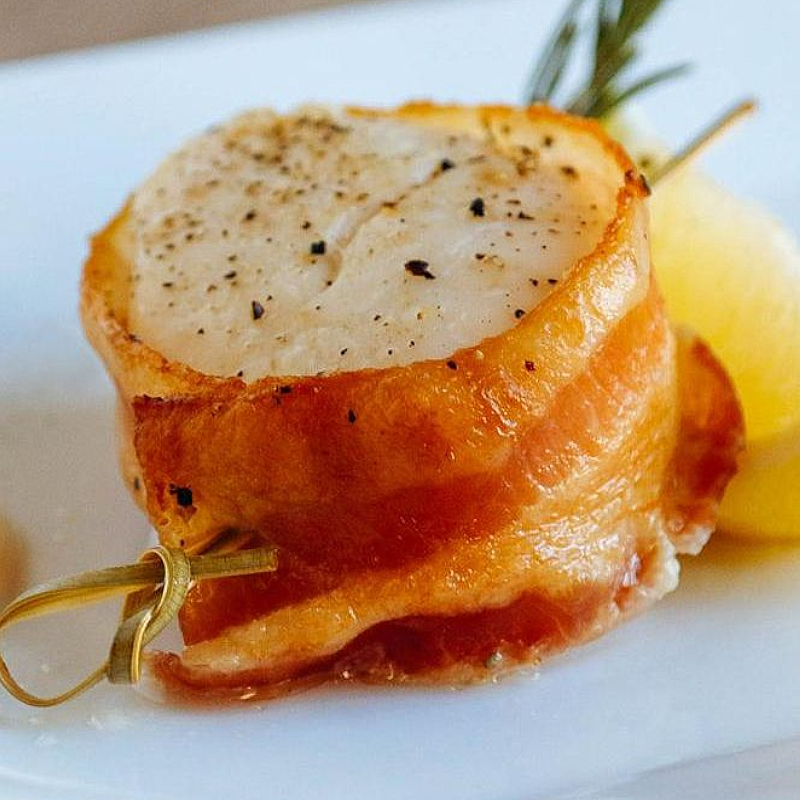Saltimbocca of Scallops with Fennel, Mandarin, and Dill
Saltimbocca of Scallops with Fennel, Mandarin, and Dill: a delicious combination of marine flavors and citrus with a hint of herbs
Here’s an elegant recipe for Saltimbocca of scallops with fennel, mandarin, and dill. This dish combines the delicate flavor of scallops, the crisp, anise-like taste of fennel, and the freshness of mandarin and dill.
Ingredients (serves 4):
- 12 scallops (without roe)
- 1 fresh fennel bulb, thinly sliced
- 2 mandarins (zest and juice)
- 1 small bunch of fresh dill
- 12 thin slices of pancetta or prosciutto
- 1 tbsp butter
- 1 tbsp olive oil
- Salt and pepper, to taste
Instructions:
-
Preparing the Scallops
Rinse the scallops gently under cold water and pat them dry with a paper towel. Season lightly with salt and pepper. -
Assembling the Saltimbocca
Wrap each scallop with a slice of pancetta or prosciutto, then secure with a toothpick to hold in place. -
Cooking the Scallops
In a skillet, heat the butter and olive oil over medium-high heat. Add the scallops wrapped in pancetta and sear for about 2 minutes on each side, until the pancetta is crispy and the scallops are cooked but still tender. -
Preparing the Garnish
In the same skillet, add the sliced fennel and sauté until tender and slightly golden, about 3-4 minutes. Deglaze with the mandarin juice, scraping the skillet to capture the browned bits. -
Plating
Arrange the fennel slices on each plate, place the scallops on top, and grate a bit of mandarin zest for a touch of freshness. Sprinkle with dill leaves for an aromatic finish.
Tips:
Serve this dish as an appetizer or main course with a salad of mixed greens or a root vegetable purée for a balanced and elegant meal.
 Garanties sécurité
Garanties sécurité
(à modifier dans le module "Réassurance")
 Politique de livraison
Politique de livraison
(à modifier dans le module "Réassurance")
 Politique retours
Politique retours
(à modifier dans le module "Réassurance")
The scallop is a delicate and prized ingredient in cooking, particularly appreciated for its tender and sweet flesh. Here are some ideas for cooking scallops:
Pan-Fried Scallops: Simply brown the scallops in a hot pan with a little butter and olive oil. Season with salt and pepper. Serve them on a bed of mashed potatoes or parsnips to accompany.
Gratinated Scallops: Prepare a creamy sauce with shallots, white wine, crème fraîche, and parsley. Place the scallops in individual shells, pour the sauce over them, sprinkle with grated cheese and brown in the oven.
Scallop Salad: Toss cooked scallops with lettuce leaves, citrus fruits (like tangerine or orange segments), sliced avocados and a light citrus juice vinaigrette.
Scallop carpaccio: Slice the scallops very thinly and place them on a plate. Drizzle with olive oil, lemon juice, add salt, pepper and fresh herbs. Serve with slices of toasted bread.
Skewered Scallops: Thread the scallops onto skewers, alternating with pieces of bacon. Grill them on the barbecue or in a pan until the bacon is crispy and the scallops are cooked.
Provençal-style scallops: Cook scallops with crushed tomatoes, garlic, Provence herbs and white wine. Serve over pasta or rice.
Scallop Risotto: Add cooked scallops to a creamy risotto. Add fish stock, white wine, and parmesan for a rich flavor.
Whatever method you choose, it is important not to overcook the scallops to preserve their tender texture. The simplicity and freshness of the ingredients are often the key to highlighting the delicacy of this seafood.
The scallop, also called "Pecten maximus", is a species of bivalve mollusc belonging to the Pectinidae family. Here are some biological aspects related to the scallop:
Habitat: Scallops are generally found in the cold waters of the North Atlantic Ocean, the North Sea and the Mediterranean Sea. They are often found on nutrient-rich seabeds.
Anatomy: The scallop is a bivalve mollusk, which means it has a shell made up of two hinged valves. The valves are often radially ridged and can have complex patterns. The fleshy part of the mollusk is called the mantle.
Food: Scallops are filter feeders. They feed by pumping water through their gills to extract food particles, such as plankton and organic debris, from the water.
Growth and Reproduction: The growth of scallops is generally slow. They can live for several years and reach a considerable size. Reproduction occurs by releasing gametes into the water, where fertilization takes place, and the larvae develop before settling on the ocean floor.
Fishing: Scallops are fished commercially for their delicious flesh and prized in cooking. Fishing can be done by dredging or trawling, and regulations are often put in place to ensure sustainable exploitation of this resource.
Ecology: Scallops play an important role in the marine ecosystem. They contribute to water filtration by feeding, and their presence influences the biodiversity of the seabed.
It is essential to note that overfishing can threaten scallop populations, and various measures are being put in place to protect this species and ensure its sustainability. Sustainable fishing practices and stock management are essential to maintaining the balance of marine ecosystems.



